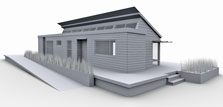

If you close your eyes, you can imagine the New York Institute of Technology house on a beach. The entire south wall, a key feature of the home, opens to the beach, breezes, and natural light.
Download Construction Drawings
(Zip 18 MB)
Neither the United States, nor the Department of Energy, nor the Alliance for Sustainable Energy LLC, nor any of their contractors, subcontractors, or their employees make any warranty, express or implied, or assume any legal liability or responsibility for the accuracy, completeness, or usefulness for any purpose of any technical resources or data attached or otherwise presented here as reference material.
Solar Decathlon 2007
New York Institute of Technology
Open Minds, Open House
Students from the New York Institute of Technology named their dwelling "Open House" for two reasons. First, they are targeting beachfront homeowners to show them how an open solar design can complement shoreline properties. Second, the term "open house" is an expression of the team's ideal home: a home with influence extending beyond its physical walls... a home that is one with its community and nature.
Integration with nature and the community begins with the architecture: a unique southern wall opens completely to the beach, blending the line between sand and walls. A white ceiling helps to maximize natural light. A contained pond on the roof reflects light back into the open space.
On the roof, an evacuated-tube solar thermal system collects solar energy for water heating and space heating. A geothermal heat pump uses the roof pond (rather than the more typical underground installation, which can't be used on the National Mall) as a heat source to provide extra heating. A building-integrated 7.7-kW PV system doubles as the shading overhang for the south wall.
Despite the home's advanced solar technology, the team was surprised at how tough it is to sell solar to the public. "We didn't realize how much more still needs to be done to have the public embrace solar," says student Daniel Rapka. "People don't realize a solar home operates like a normal home."
Another layer of integration is the home automation system or "smart house" feature. This system allows people to get real-time data on energy use. The home automation system serves as an educational tool by giving the public a user-friendly way to view a home's energy use.
"The smart house feature ties into our open house idea where not only homeowners learn about the house, but homeowners could put their energy-use information up on a blog so the community could share in the information," says student Matt Mathosian. "People could log on to a Web site where they could comment about energy use."
Team Contact
Thomas Rochon
tra@thomasrochon.com
